- 1School of Life Sciences, Guangzhou University, Guangzhou, China
- 2College of Materials and Energy, South China Agricultural University, Guangzhou, China
- 3Guangdong Institute of Eco-environmental Science and Technology, Guangzhou, China
- 4Entomology III, Senckenberg Research Institute and Natural History Museum, Frankfurt, Germany
The Qinghai-Tibet Plateau sensu lato (QTP s.l.) harbors an exceptionally high biodiversity, especially at its southeastern margin: this area encompasses the Hengduan Mountains and the eastern Himalayas, which have been listed as biodiversity hotspots. To the contrary, the plateau interior (namely the Qinghai-Tibet Plateau sensu stricto, QTP s.s.) is relatively species-poor because of its particularly harsh climate. With contrasting geological histories and environmental conditions of the Hengduan Mountains, the Himalayas, and the QTP s.s., it would be expected that floristic compositions and diversity patterns of these three regions would differ between each other. To compare the floristic diversity of these three regions, we assembled data on seed plant's distribution in the three regions based on county-level mapping from published monographs and online databases, and we then analyzed their floristic features and species diversity patterns (horizontal and elevational). We found that the Hengduan Mountains hosted the most seed plant species (8,439), as expected. The highest percentage of shrub (22.88%) and tree species (9.80%) were in the Himalayas, whereas herbaceous species (81.50%) were relatively more prominent in the QTP s.s. The Hengduan Mountains also had the most species-rich genera (10) with more than 50% of their total species diversity in China. Also, temperate genera dominated across these three regions, with a highest percentage (77.61%) within the QTP s.s. Across the QTP s.l., species diversity gradually decreased from the southeastern part to the northwest, and most of seed plants were distributed in the southern and eastern margin of the Hengduan Mountains and East Himalayas. Along elevational gradients, species richness all demonstrated a hump-shape curve, but the most species-rich elevation zone differed for each type of life-form across the three regions. Our study sets a base for exploring the origin and evolution of mountain taxa, as well as provides a snapshot of the current plant distribution, which will certainly be modified by climate change.
Introduction
Mountainous regions harbor about one-quarter of terrestrial species, and inevitably, some of these areas have been listed as hotspots of biodiversity, including for example the two most diverse mountainous regions on Earth: the Andes and the Hengduan Mountains (Marchese, 2015; Hoorn et al., 2018). The establishment of high biodiversity levels in these remarkable mountain systems is likely to result from the combination of global and local abiotic conditions (e.g., geological and climatic processes) with biotic, often taxon-specific features (e.g., key innovations) (Lagomarsino et al., 2016). As stated in the “mountain geobiodiversity hypothesis” (Mosbrugger et al., 2018), the development of a full altitudinal zonation (i.e., thermal belts) and high ruggedness of the terrain is expected to foster the immigration of foreign pre-adapted lineages (biological interchange), whereas at the same time lowering the risk of climate-driven extinction by providing numerous alternative habitat within a short distance. Yet, high speciation rate would be achieved only during cyclical modifications of distribution ranges (i.e., species-pump effect). Indeed, radiations, which are major contributors to mountain biodiversity, appear to be concentrated in the last few million years (thus overlapping with climate oscillations), whereas mountain building started much earlier (Hughes and Atchison, 2015; Muellner-Riehl et al., 2019). Obviously, mountain building and past climate changes are crucial triggers of complex evolutionary processes accounting for species diversity in mountains (Antonelli et al., 2018; Rahbek et al., 2019). Thus, understanding the profile of species diversity in such a region could provide general and valuable insights into the recent evolution of local taxa, as well as help prioritizing conservation strategies of regional biota.
As the largest and highest plateau region on Earth, the Qinghai-Tibet Plateau sensu lato (QTP s.l.) harbors a great number of mountain plant species (Zhang et al., 2016). The QTP s.l. consists of three major regions: the Hengduan Mountains to the East, the Himalayas in the South and the Qinghai-Tibet Plateau sensu stricto (QTP s.s.). Among these, the Hengduan Mountains and the eastern Himalayas are two of the most important biodiversity hotspots in the world (Marchese, 2015). Over long period of time (from late Miocene onwards), the Hengduan Mountains have experienced a complex and rapid uplift that produced extreme ruggedness of the terrain as well as a remarkable environmental heterogeneity (Wang et al., 2012). In contrast, the QTP s.s. is most likely to be more ancient, with an uplift starting at least around the India-Asia collision [c. 55 Ma, (Favre et al., 2015)], with subsequent outward extensions (Mulch and Chamberlain, 2006). The QTP s.s. is particularly vast and high (c. 4,500 m in average) but displays only a low ruggedness. The Himalayas experienced a rather rapid orogeny starting during the Miocene (Deng and Ding, 2015; Ding et al., 2017), with the Qomolangma (Mt. Everest) attaining c. 5,000 m already during the early Miocene (Gébelin et al., 2013). The uplift of high mountain ranges resulted in modifications of the distribution of precipitations, with a probable intensifying effect on the East Asian monsoon and the Indian monsoon, progressively generating modern climatic patterns in Asia (An et al., 2001). Currently, there is a strong climatic gradient from warm and humid conditions (in the southeast, in the Hengduan Mountains and East Himalayas) to cold and dry climatic regimes behind the rain shadow (in the center and northwest, in the QTP s.s.). The three regions differing from each other in their uplift history and topography, as well as in their climatic regime, distinctive evolutionary trajectories of species would be expected. For example, it is known that the Hengduan Mountains hosted higher in situ diversification rates than the other two regions over the past 10 Ma, during which time the overall dispersal rate from the Hengduan Mountains into the Himalayas and QTP s.s. increased gradually (Xing and Ree, 2017). A number of radiations of mountain genera occurred simultaneously with the uplift of the Hengduan Mountains and climate oscillations, including for example Gentiana (Favre et al., 2016) and Saxifraga (Ebersbach et al., 2017). Serving as a source area for multiple genera that colonized other areas of the world (e.g., Matuszak et al., 2016), and characterized by many radiations, the Hengduan Mountains are often depicted as a cradle of evolution for many temperate taxa (Chen et al., 2018; Lu et al., 2018).
Probably because of its roughly north-south orientation and rugged nature, the Hengduan Mountains appears to have experienced lower extinction rates during climatic oscillations. Hence, this region is usually viewed as important refugium preserving high levels of species and genetic diversity during glacials (Qiu et al., 2011; Yu et al., 2019b). In comparison, the east-west orientation of the Himalayas and the low ruggedness of the QTP s.s. rendered their fauna and flora more susceptible to be extinction during climate oscillations, leading to vacant niches and recolonization from the Hengduan Mountains during interglacials (e.g., Cun and Wang, 2010; Liu et al., 2013; Xing and Ree, 2017). However, there were several microrefugia in the last two regions that have probably preserved number of plant taxa (Liu et al., 2012). On the other hand, under current climate projections, plant species within the Hengduan Mountains and Himalayas are predicted to expand their range sizes as they shift upslope or westward into the QTP s.s., and species richness in the Hengduan Mountains and QTP s.s. is expected to undergo great increases with expected climate warming [(Liang et al., 2018; He et al., 2019a,b)]. However, species richness in the Himalayas would remain almost stable (Liang et al., 2018).
Evolutionary studies targeting this region usually lump the entire area as one (the QTP s.l.). However, due to their distinct uplift histories and environmental conditions (i.e., climate and topography), the Hengduan Mountains, the Himalayas and the QTP s.s., are likely to differ in terms of evolutionary processes as well as overall response of their vegetation to climate change. Hence, there could be profound differences in floristic diversity amongst these three regions. In this study, we aim to investigate the features and distributions of plant diversity in these regions, and among other aspects distinguishing between life-forms (i.e., herb, shrub, and tree).
Methods
Study Area
The QTP s.l. in China is the largest (c. 2.5 × 106 km2) and highest plateau (average elevation > c. 4,000 m) in the world (Zhang et al., 2002; Figure 1A). The relative abundance of its main biomes (forest, alpine meadow, alpine steppe, and alpine desert) varies along a southeast to the northwest gradient following climatic characteristics. The area can be divided into three regions (Figure 1B). First, the Hengduan Mountains (total area of c. 3.9 × 105 km2, average elevation > c. 4,000 m), are located at the southeastern edge of the plateau. This region is topographically complex with numerous north-south oriented mountain ranges and deep valleys. In terms of climate, this region is influenced heavily by both the East Asian monsoon and Indian monsoon (Figure 1C), and thus characterized by higher annual mean temperature and precipitation (Figure 1D). Then, the Himalayas (confined to the territory of China in this study) at the southern edge of the plateau, are a very long and narrow mountain range (east-west orientation) with a vast elevational gradient (Figure 1E), spanning over 20 degrees of longitude (c. 79–99°E). It covers about 3.1 × 105 km2 with average elevation above 4,200 m. Because of the rain shadow effect, there is a contrasting climatic pattern in the Himalayas between their southern (warm and wet) and northern slopes (cold and dry). The third and largest area (c. 1.8 × 106 km2) is the QTP s.s. itself, with a higher mean elevation (> c. 4,500 m) and particularly harsh cold and dry climate in its northwestern part, whereas its eastern (e.g., the Qilian Mountains) and southeastern margins have relatively warm and wet climate influenced by the East Asian monsoon.
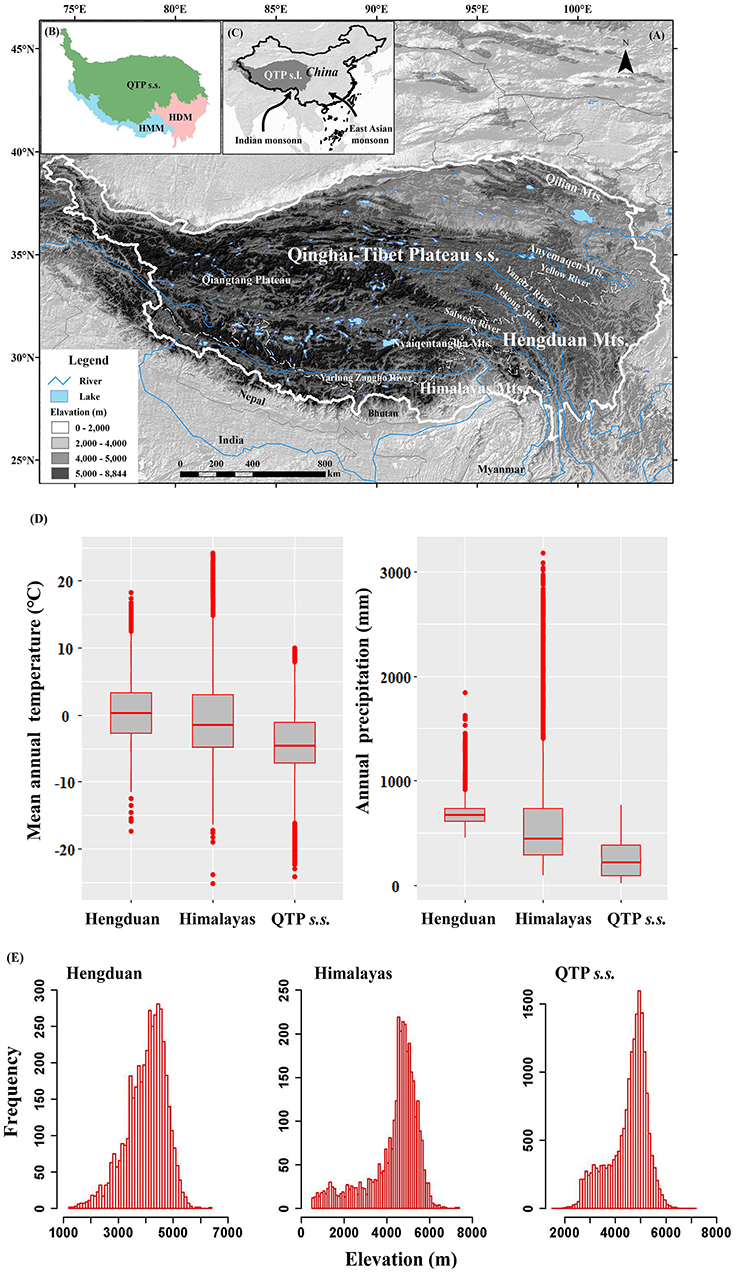
Figure 1. The approximate boundary of the region of the Qinghai-Tibet Plateau in China and corresponding environmental conditions. (A) geographical area of the Qinghai-Tibet Plateau s.l. and its direct surrounding. (B) the Qinghai-Tibet Plateau s.l. contains three major regions, including the Hengduan Mountains (HDM), the Himalayas (HMM), and the Qinghai-Tibet Plateau s.s. (QTP s.s.). (C) each summer, this plateau is profoundly influenced by the Indian and East Asian monsoons. (D) the distributions of annual mean temperature and annual precipitation in the Hengduan Mountains, the Himalayas and the Qinghai-Tibet Plateau s.s. (E) the histograms of elevation in the Hengduan Mountains, the Himalayas, and the Qinghai-Tibet Plateau s.s. The boundary of the Qinghai-Tibet Plateau s.l. refers to Zhang et al. (2002), and the scopes of these three typical regions refer to Körner et al. (2017), Xing and Ree (2017), and Liang et al. (2018).
Collection of Species List and Distribution Data
First, we established the list of seed plant species (including intraspecific taxa) occurring in the QTP s.l. in China, and recorded their spatial distributions at the county level within each of the three regions (the Hengduan Mountains, the Himalayas and the QTP s.s.) investigated. Because species information within the southern parts of the Himalayas (e.g., Nepal, Bhutan, Sikkim, Kashmir) were difficult to obtain, we only considered the species distribution within the northern Himalayas (Chinese territory). We gathered information from the following monographs: The Vascular Plants and Their Eco-geographical Distribution of the Qinghai-Tibetan Plateau (Wu, 2008), Flora Reipublicae Popularis Sinicae (Editorial Committee of Flora Reipublicae Popularis Sinicae, 1959–2004), Flora of China (Wu et al., 1994-2013), floras of Tibet, Qinghai, Sichuan, Yunnan, Gansu and Xinjiang, and the Vascular Plants of the Hengduan Mountains (The Comprehensive Scientific Expedition to the Qinghai Xizang Plateau Chinese Academy of Sciences, 1993-1994), as well as field vegetation surveys in the Qiangtang Plateau. For species with only approximate distribution data, we further referred to several online databases, such as the Chinese Virtual Herbarium (https://www.cvh.ac.cn/) and the Global Biodiversity Information Facility (https://www.gbif.org/). For nomenclatural consistency across these sources, the preliminary species list was based on the Flora of China, and unresolved or synonymous species names were excluded. The following information was recorded for each species: (i) life-form (tree, shrub, or herb), (ii) elevational range and (iii) whether it is endemic (only found in the QTP s.l.) or (iv) alpine (distributed above the tree line). We followed the APG IV classification system (The Angiosperm Phylogeny Group et al., 2016).
Basic Statistics and Floristic Composition Analysis
Basic analyses within the Hengduan Mountains, the Himalayas, the QTP s.s. and the QTP s.l. in China were conducted as follows: (1) we calculated the absolute and relative number of each life-form within each individual region; (2) we calculated similarity coefficients of all seed plant species and endemic species between the Hengduan Mountains, the Himalayas and the QTP s.s. at the family, genus and species levels; (3) we established a list of top 20 families/genera for each region and calculated their percentage of species in a family/genus in China; (4) Based on the areal types of the families and genera of seed plants proposed by Wu et al. (2006), we calculated the geographical floristic composition of the families and genera of seed plants within these regions.
Mapping Species Diversity Patterns
We counted the number of each life-form taxa in each county of the QTP s.l. in China and built their species richness patterns at the county level using the ArcGIS 10.1 (Environmental Systems Research Institute, Inc., Redlands, CA). We built the patterns of ratio of endemic and alpine species in a county across the QTP s.l. We also built the patterns of weighted endemism (WE; Linder, 2001) at the species and genus levels. Then, we built the elevational diversity patterns of each life-form taxa within the Hengduan Mountains, the Himalayas and the QTP s.s., and the frequency line of species richness along the elevation was drawn using R 3.6.2 (R Core Team, 2016).
Results
Floras of the Hengduan Mountains, the Himalayas, and the QTP s.s.
Among these three mountain regions, the Hengduan Mountains harbored the most seed plant species (8,439), belonging to 184 families and 1,273 genera (see Appendix 1), of which 5,817 (68.93%) species were herbaceous, 1,896 (22.47%) were shrubs, and 726 (8.60%) were trees (Table 1). In contrast, the Himalayas and the QTP s.s. had 5,468 (177 families and 1,146 genera) species and 3,908 (122 families and 746 genera) species (see Appendixes 2, 3), respectively. Within the Himalayas, the majority of species were herbaceous (3,681 species; 67.32%), also including the highest percentage of shrub (1,251, 22.88%) and tree species (536, 9.80%) across the three regions. The QTP s.s. had the largest proportion of herbaceous species (3,185; 81.50%), with additional 556 (14.23%) shrubs and 167 (4.27%) tree species. In total, the QTP s.l. recorded 12,091 seed plant species (200 families and 1,574 genera) with 8,513 (70.41%) herbs, 2,558 (21.16%) shrubs and 1,020 (8.43%) trees, of which 5,457 (45.13%) species were endemic, as well as 3,320 (27.46%) alpine species. Besides, the similarity coefficients of all species and endemic species composition at the family level between each region were higher than that of the genus and species levels. Among these, the coefficients between the Hengduan Mountains and Himalayas at the three levels were the highest (Tables 2A,B).

Table 1. The basic floristic diversity of the Hengduan Mountains, the Himalayas, the Qinghai-Tibet Plateau s.s., and the Qinghai-Tibet Plateau s.l.
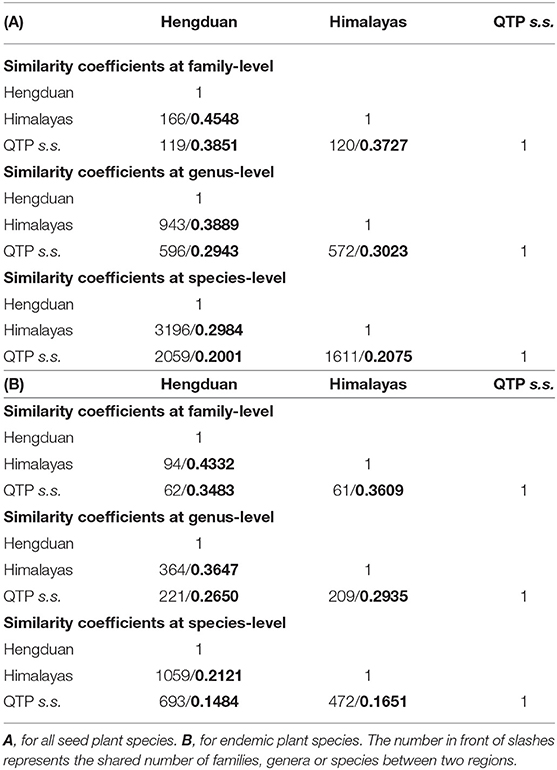
Table 2. Similarity coefficients of floristic composition between the Hengduan Mountains, the Himalayas, and the Qinghai-Tibet Plateau s.s. at the family, genus and species levels.
Seventeen of the top 20 big families were common across all regions, but the number of species in these families varied in each region (Table 3). More than half of species diversity was located in the Hengduan Mountains for three families (Rosaceae, Orobanchaceae, and Gentianaceae). At the genus level, about 12 of the 20 largest genera were common throughout but the most represented genera differed between regions (Table 4).
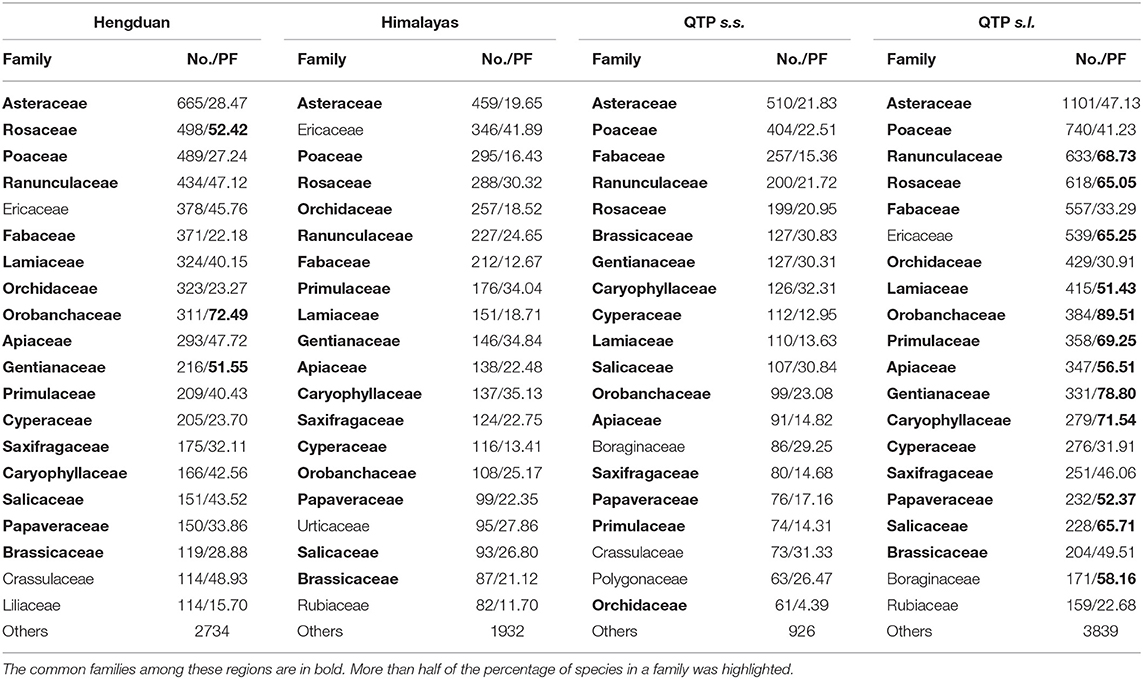
Table 3. Top 20 big families for the Hengduan Mountains, the Himalayas, the Qinghai-Tibet Plateau s.s., and the Qinghai-Tibet Plateau s.l. and their percentage of species in their respective family in China (PF).
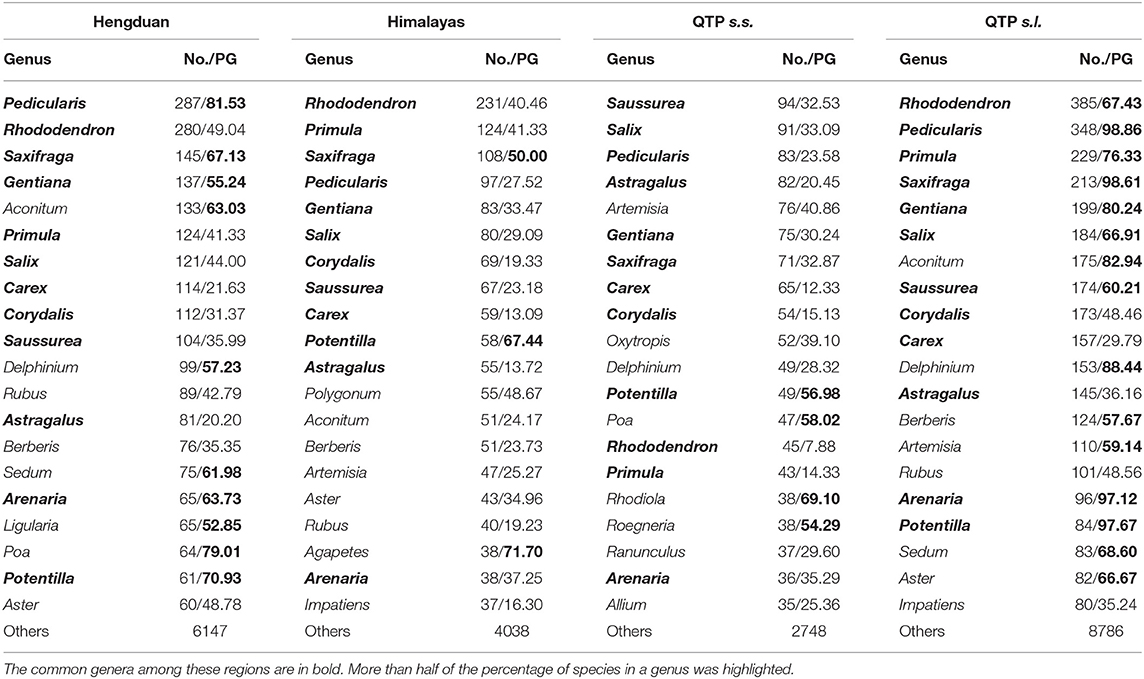
Table 4. Top 20 big genera for the Hengduan Mountains, the Himalayas, the Qinghai-Tibet Plateau s.s., and the Qinghai-Tibet Plateau s.l. and their percentage of species in their respective genus in China (PG).
The floras of the Hengduan Mountains and the Himalayas included relatively more typically tropical families than temperate ones, which was not the case in the QTP s.s. (Table 5). However, at the genus level, the percentage of typically temperate genera was higher than tropical ones in all three regions (Table 6). Large proportion of these temperate genera showed affinities with the flora of north temperate and East Asia.
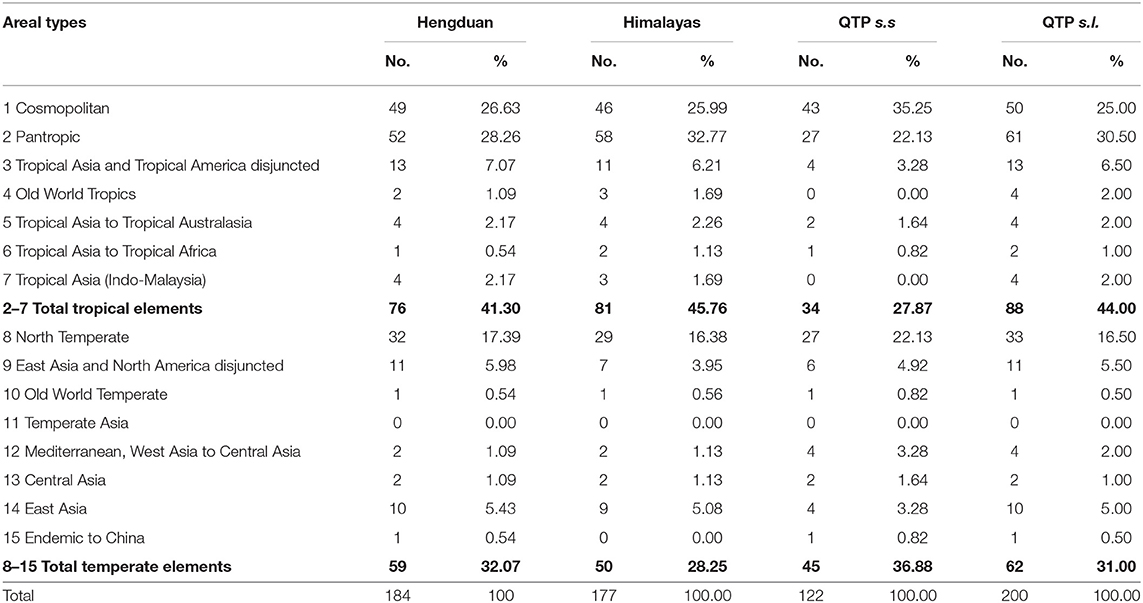
Table 5. Geographical elements of seed plants of the Hengduan Mountains, the Himalayas, the Qinghai-Tibet Plateau s.s., and the Qinghai-Tibet Plateau s.l. at the family level.
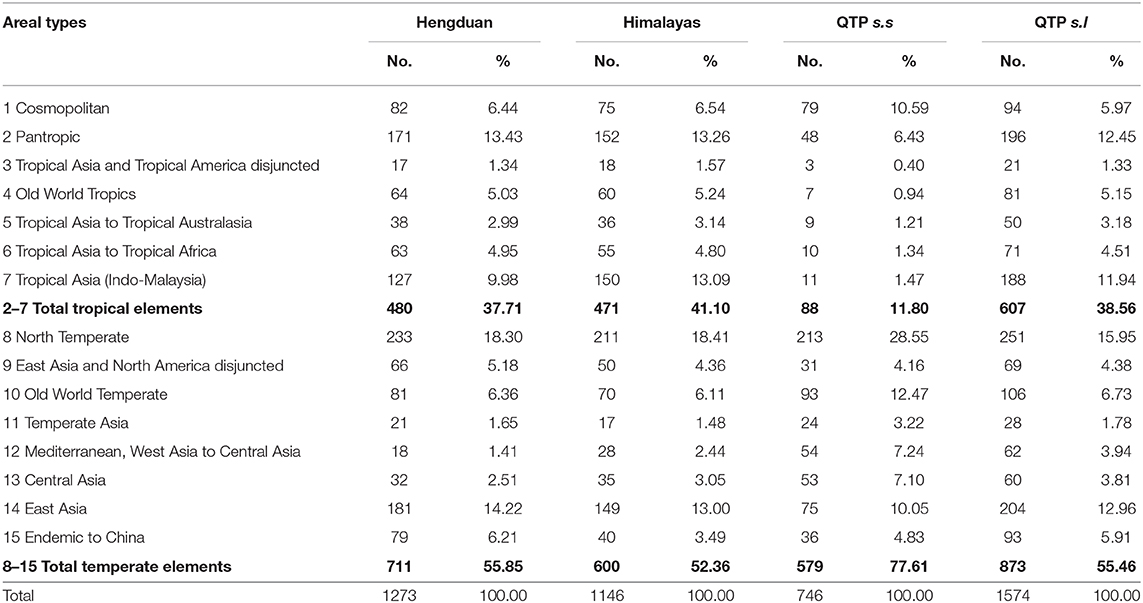
Table 6. Geographical elements of seed plants of the Hengduan Mountains, the Himalayas, the Qinghai-Tibet Plateau s.s., and the Qinghai-Tibet Plateau s.l. at the genus level.
Diversity Patterns
Across the QTP s.l., species diversity (also within each life-form taxa) gradually decreased from the southeastern part to the northwest (Figures 2A–D). Most parts of the Hengduan Mountains hosted a high percentage of endemics (Figure 2E), but the southern and eastern parts of the range were particularly species-rich. The most diverse part of the Himalayas was located in its eastern quarter. However, relatively high diversity was also found in the central Himalayas. Those mentioned areas also have a high level of weighted endemism (Figures 2G,H). In comparison, species diversity in the QTP s.s. was relatively low, except in the Qilian Mountains, the Anyemaqen Mountains and the Three-River Headwaters Region (East). The local flora is characterized by a high proportion of alpine plants (Figure 2F).
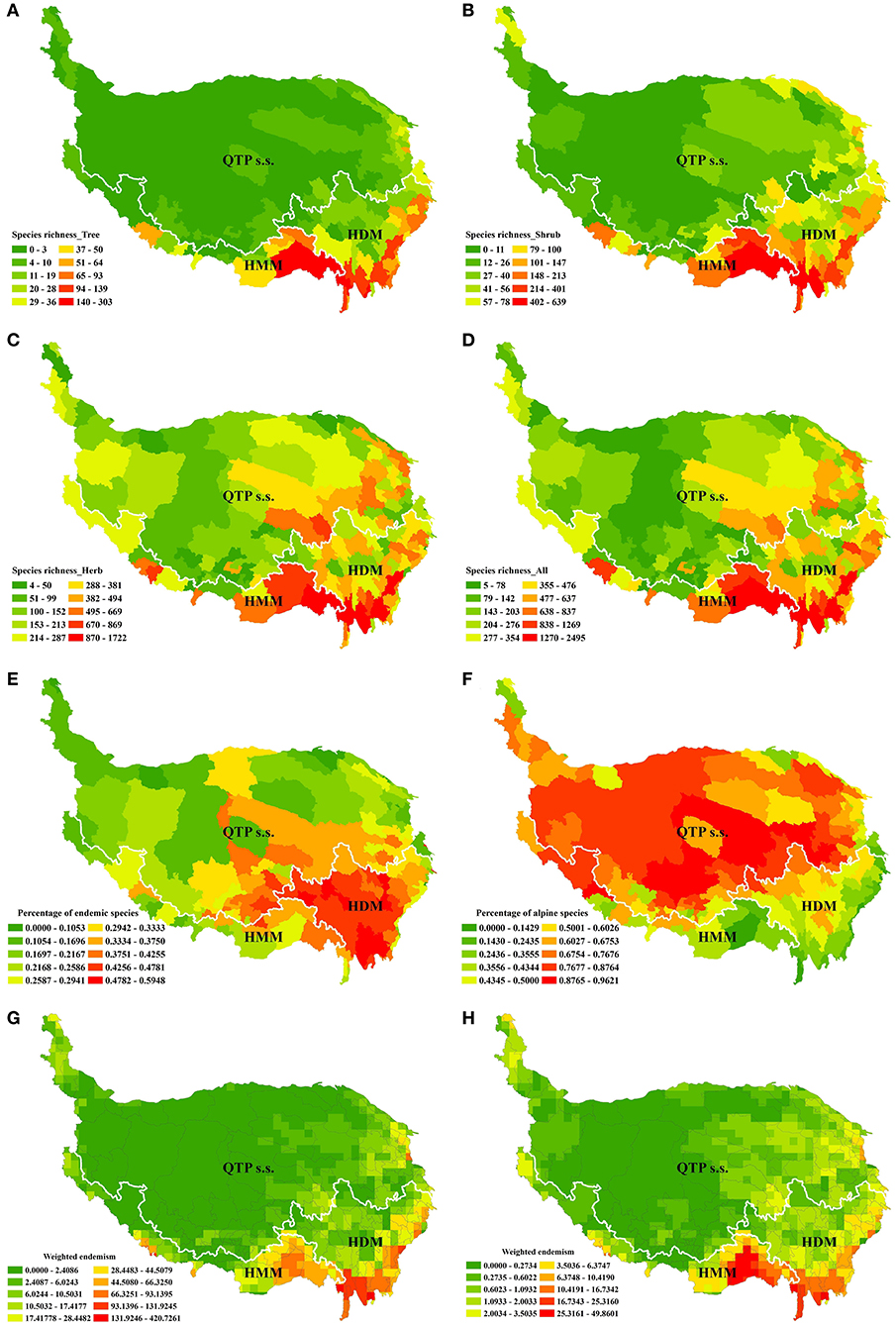
Figure 2. Patterns of floristic diversity in the Qinghai-Tibet Plateau s.l. (A–D) patterns of species richness for tree, shrub, herbaceous plants, and all species. (E) pattern of ratio of endemic species in a county. (F) pattern of ratio of alpine species in a county. (G,H) patterns of weighted endemism at the species and genus levels. HDM, the Hengduan Mountains; HMM, the Himalayas; QTP s.s., the Qinghai-Tibet Plateau sensu stricto. White lines represent the boundary between the Hengduan Mountains, the Himalayas and the QTP s.s.
Along altitudinal gradients, species richness was always characterized by a hump-shape curve for different life-form types, but most species were located within distinct elevational zones within the three regions (Figures 3A–D). For example, most herbaceous species were located between 2,500 and 3,500 m (Hengduan Mountains), 2,700 and 3,700 m (Himalayas), and 3,100 and 4,100 m (QTP s.s.), respectively. In contrast, shrubs were mainly distributed between 2,100 and 3,100 m in the Hengduan Mountains, 2,200 and 3,200 m in the Himalayas, and 2,600 and 3,600 m in the QTP s.s. Most tree species were distributed between 2,000 and 3,000 m across these three regions.
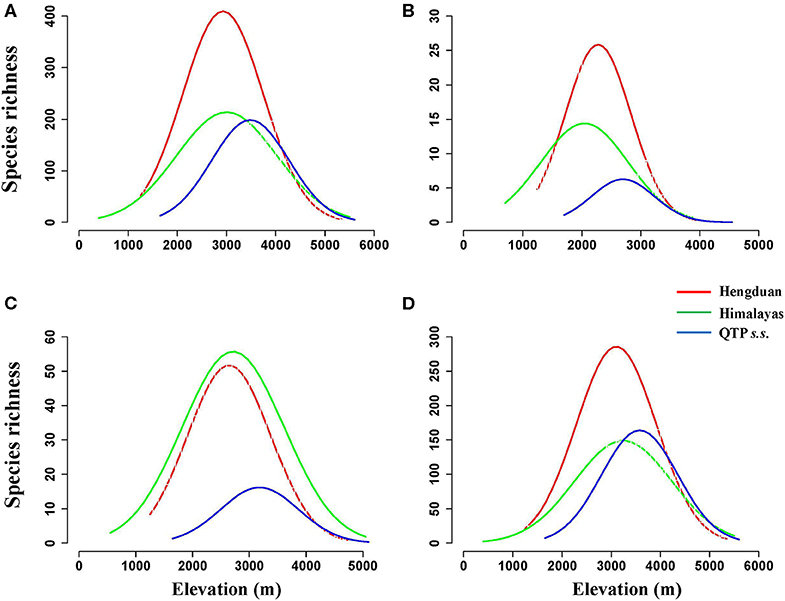
Figure 3. Elevational patterns of species richness among the Hengduan Mountains, the Himalayas, and the Qinghai-Tibet Plateau s.s. for different life-forms taxa. (A) all species. (B) tree species. (C) shrub species. (D) herbaceous species.
Discussion
Although the Hengduan Mountains, the Himalayas and the QTP s.s. are adjacent to each other, their respective flora present distinct features and diversity patterns. The Hengduan Mountains host the most species and higher percentage of endemics, as expected, whereas the Himalayas and the QTP s.s. have relatively low species diversity. Across the QTP s.l., species diversity gradually decreased from the southeastern to the northwest part, and most of seed plants were located in the southern and eastern margin of the Hengduan Mountains and East Himalayas. Along elevational gradients, species richness all demonstrated a hump-shape curve, but the maximum zones for each life-form differed across the three regions. These are probably due to local climatic and topographic complexity, as well as geological and climatic histories. Below we discussed these floristic findings more in detail.
The Flora of the Hengduan Mountains: As a Cradle of Evolution
Undoubtedly, the Hengduan Mountains host the most plant species in the region (see Table 1). This could partly be explained by current climatic and topographic conditions: the Hengduan Mountains are under a relatively generous climate, while their rugged terrain allows for a high diversity of habitats (Yu et al., 2019a). Such favorable conditions are currently also found in other species-rich mountainous areas, such as the Andes (Luebert and Weigend, 2014) and the Tropical Mountains of African (Marshall et al., 2016). However, as shown in Muellner-Riehl et al. (2019), historical factors have played an important role for species richness there. For example, extinction risks during climate oscillations were probably buffered by vast altitudinal gradients, allowing for a substantial overlap of altitudinal distribution of temperatures between glacials and interglacials. At the same time, climate oscillations are likely to have generated a species-pump effect (Mosbrugger et al., 2018), fostering a number of radiations. The region is thus often depicted as a cradle of evolution (Lu et al., 2018), at least since the frequency of radiations has increased with the uplift of the Hengduan Mountains [c. 7–8 Ma, (Xing and Ree, 2017; Muellner-Riehl et al., 2019)]. These radiations predominantly occurred in herbaceous plant genera (see Table 4), such as Pedicularis (Yu et al., 2015), Gentiana (Favre et al., 2016), and Saxifraga (Ebersbach et al., 2017), and occasionally in shrub taxa such as Rhododendron (Yan et al., 2015). This is reflected in our results, with herbaceous plants accounting for a larger proportion of the flora of the Hengduan Mountains (see Table 1) than would be expected under these latitudes. Besides, amounts of genera in the Hengduan Mountains have experienced in-situ diversification, and most of them could colonize the East Asia and north temperate (e.g., Favre et al., 2016; Matuszak et al., 2016), generating large proportion of the East Asia and north temperate elements in this mountain region (see Table 6).
The Flora of the Himalayas: Relatively Less Radiations but More Immigration
Although the number of species occurring in the Himalayas is only 65% of that in the Hengduan Mountains, the two regions present a high floristic similarity (see Table 2). This may indicate that relatively less species resulted from in-situ radiations, and proportionally more from immigration in the Himalayas. In fact, Xing and Ree (2017) have found that biological interchange between the Hengduan Mountains and the Himalayas has increased in the last few million years (simultaneously with climate oscillations), and in an asymmetrical manner: immigration from the Hengduan Mountains to the Himalayas is more frequent than the other way around. This may be explained by the East-West orientation of the Himalayas and the presence of a sharp rain shadow, both of which might have rendered species of this region more prone to extinction during climate oscillations than in the Hengduan Mountains. Vacant niches were then filled from the neighboring species stock surviving in the Hengduan Mountains (Ren et al., 2015; Yan et al., 2015; Ebersbach et al., 2017). However, because species in the southern Himalayas (more favorable habitats and plenty altitudinal gradients) were not considered in this study, it should be aware of that the flora of the Himalayas is likely to be underestimated, and there could be several micro-refugia preserving amounts of species in the southern Himalayas. Also, most parts of South Himalayas belong to subtropical and tropical regions, an increasing number of tropical elements could be found there. Thus, exploring the flora of southern Himalayas (beyond the Chinese territory) would provide an important supplement to understand the floristic diversity of the QTP s.l.
The Flora of the QTP s.s.: Fewer but More Specialized Species
Although the QTP s.s., occupies 72% of the QTP s.l., its species diversity is less than half that of the Hengduan Mountains (c. 46%). Most of these species are herbaceous (81.50%, see Table 1). This clearly is the result of an extremely cold and dry climate, preventing most tree and shrub species to grow. Such hash and alpine habitats resulted in large proportion of temperate elements of genus (see Table 6), these dominant temperate elements were also found in the alpine subnival belt of the Hengduan Mountains and Shangri-La in northwestern Yunnan (Xu et al., 2014; Zhu, 2015). Little evidence exists for its biological interchange with the Himalayas and the Hengduan Mountains, and the species similarity between the QTP s.s. and the Hengduan Mountains, the Himalayas are only c. 20% (see Table 2). This might be further explained by the absence of some thermal belts of lower elevation, and the low ruggedness of the terrain. In fact, during climate oscillations, vegetation types (e.g., grasslands and forests) are more likely to have replaced each other over time rather than accumulated (Qiu et al., 2011), thus causing the local extinction of entire communities. Furthermore, only few radiations are centered on the QTP s.s., with a significant number of local endemics (e.g., in Poa, Rhodiola, Saussurea, Salix, and Astragalus) (see Table 4), all of these genera being strongly specialized to extreme alpine habitats. Some other diverse genera, such as Salix, would benefit from azonal vegetation near bodies of water. Molecular studies for Saussurea and Rhodiola have suggested that these genera radiated because of geological processes, such as the uplifts of the QTP s.s. (Zhang et al., 2014; Xu et al., 2019). This has been strongly criticized (see Renner, 2016), and an increasing number of publications tend to associate radiations with faster and more profound changes in the environment such as climate oscillations (among others, Mosbrugger et al., 2018; Muellner-Riehl et al., 2019).
Gradients of Species Diversity Within the Hengduan Mountains, the Himalayas and the QTP s.s.
Over the entire region, plant species diversity decreases gradually, roughly from the southeastern edge of the QTP s.l. This pattern follows general trends in terms of climate (warm and wet to cold and dry), mean elevation (low to high) and topography (high to low ruggedness). This overall gradient superimposes with more local ones in each of the three regions (see Figures 2A–D). For example, the southern part of the Hengduan Mountains (higher precipitation and ruggedness) is richer in term of species than the northern part (relatively less wet and rugged). The southern Hengduan Mountains is also a transition zone with incursion of numerous species of the Yunnan Plateau (subtropical taxa) (Zhu, 2012), for example in the Gaoligong Mountains and the Nujiang Valley. Furthermore, this area is a vital glacial refugium (Yu et al., 2019b). To the contrary, vast expands of the northern part of the Hengduan Mountains are more high plateau-like, such as the Litang and the Songpan Plateaus, which were likely more prone to extinction during glaciations and less permeable to the immigration of non-local floristic elements.
In the Himalayas, there is a clear decrease of diversity pattern from the east to the west. The eastern Himalayas have similar climatic and topographic conditions as the southern Hengduan Mountains. However, in the central and western Himalayas, because most areas are located within the rain shadow zone and influenced slightly by the monsoon system, species become less (drought-tolerant plant dominate), only several valleys in the southern slope (plentiful rainfall) such as the Zhangmu Valley, Jilong Valley, Yadong Valley have remarkable amounts of species.
The interior of the QTP s.l. (i.e., QTP s.s.) is extremely high with average elevation above 4,500 m. Alpine species dominate this region (see Figure 2F). Duo to climatic and elevational gradients from the southeast to the northwest, species diversity reduces gradually along this direction. However, the southeastern and eastern margin areas (e.g., the Three-River Headwaters Region, the Qilian Mountains) have a higher topographic heterogeneity and are partially affected by the monsoons, leading to the occurrence of relatively more species there. Moreover, several glacial micro-refugia were located within these areas that could preserve multiple species, as suggested in Yu et al. (2019b). However, that study included a large spectrum of species without considering their ecological preferences, and was not specific to any thermal belts. Although Yu et al. (2019b) probably revealed some hotspots of genetic diversity on the QTP platform, their importance may vary whether or not only species with similar ecology were included in the analysis.
Altitudinal Gradients
Along elevational gradients, species richness for each life-form taxa presents a hump-shape curve across all three regions (see Figure 3). Such pattern was also discussed in the Gaoligong Mountain (Wang et al., 2007), the Gongga Mountain (Zu et al., 2019), the eastern Himalayas (Sharma et al., 2019), and other montane regions in the world (e.g., Quintero and Jetz, 2018). Usually, ecological and evolutionary factors account for this elevational pattern of species diversity (Laiolo et al., 2018). For example, within the Hengduan Mountains, the other side of large valleys such as the Jinsha River, Mekong River (Lancang) and Salween River (Nujiang) are rain shadow zones, indicating that the foot of a valley is much drier, and thus only the mid-elevation zone is wetter and can sustain more species. From an evolutionary standpoint, habitats of intermediate elevation could have had more time for speciation/diversification and the accumulation of species, thus generating high species richness at mid-elevations [mountain museum hypothesis; (Stephens and Wiens, 2002)]. This hypothesis was for example supported by a study targeting the high endemic diversity of the QTP s.l. (Yu et al., 2019a). Muellner-Riehl et al. (2019) also argued that mountain systems hosting relatively more species were those characterized by the largest overlap in altitudinal gradients of temperatures between glacials and interglacials. The mid-elevation thermal belts might thus have acted as refugium in general. In addition, occurrence of high species richness along the elevation varies among these three regions. We assumed that this could be related to climatic variation of these regions. For example, the Hengduan Mountains and Himalayas have more suitable climatic conditions (abundant rainfall and varied temperature profiles), leading to a high species richness at lower elevation than that of the QTP s.s.
Conclusions
The vast QTP s.l. is highly heterogeneous (e.g., topography, climate) and its biodiversity is the result of complex and contrasting evolutionary histories. The Hengduan Mountains, the Himalayas and the QTP s.s. demonstrate distinct floristic features and diversity patterns, which in parts reflects their individual process of species assemblage deriving from their contrasting geological and climatic histories. Exploring the current distribution of biodiversity and its evolutionary origin is essential to forecasting threats to biodiversity under current and future climate changes and human activities. Our study thus represent a first necessary step to suggest valid conservation strategies to protect this unique and precious plateau region.
Data Availability Statement
All datasets for this study are included in the article/Supplementary Material.
Author Contributions
HY, AF, ZC, SM, and GX conceived the study. HY and XG collected the data. HY led data analysis and writing. AF contributed to the writing. All authors contributed critically to the drafts and gave final approval for publication.
Funding
This study was funded by the National Natural Science Foundation of China (31901212), Talent Start-up Foundation of Guangzhou University (RP2020079), and Science and Technology Planning Project of Guangdong Province, China (2018B030320007). AF was supported by the German Science Foundation (project no. AF1117/1-2).
Conflict of Interest
The authors declare that the research was conducted in the absence of any commercial or financial relationships that could be construed as a potential conflict of interest.
Acknowledgments
We thank several herbariums from Institute of Botany (Chinese Academy of Sciences, CAS), Kunming Institute of Botany (CAS), and Northwest Institute of Plateau Biology (CAS) for sharing the species distribution data. We also thank the editor and two reviewers for their constructive comments that greatly improved this study.
Supplementary Material
The Supplementary Material for this article can be found online at: https://www.frontiersin.org/articles/10.3389/fevo.2020.00136/full#supplementary-material
Appendix 1. The seed plant list for the Hengduan Mountains.
Appendix 2. The seed plant list for the Himalayas in China.
Appendix 3. The seed plant list for the QTP s.s.
References
An, Z., Kutzbach, J. E., Prell, W. L., and Porter, S. C. (2001). Evolution of Asian monsoons and phased uplift of the Himalaya-Tibetan plateau since late miocene times. Nature 411, 62–66. doi: 10.1038/35075035
Antonelli, A., Kissling, W. D., Flantua, S. G., Bermúdez, M. A., Mulch, A., Muellner-Riehl, A. N., et al. (2018). Geological and climatic influences on mountain biodiversity. Nat. Geosci. 11, 718–725. doi: 10.1038/s41561-018-0236-z
Chen, Y., Deng, T., Zhou, Z., and Sun, H. (2018). Is the East Asian flora ancient or not? Natl. Sci. Rev. 5, 920–932. doi: 10.1093/nsr/nwx156
Cun, Y., and Wang, X. (2010). Plant recolonization in the Himalaya from the southeastern Qinghai-Tibetan Plateau: Geographical isolation contributed to high population differentiation. Mol. Phylogenet. Evol. 56, 972–982. doi: 10.1016/j.ympev.2010.05.007
Deng, T., and Ding, L. (2015). Paleoaltimetry reconstructions of the Tibetan Plateau: progress and contradictions. Natl. Sci. Rev. 2, 417–437. doi: 10.1093/nsr/nwv062
Ding, L., Spicer, R. A., Yang, J., Xu, Q., Cai, F., Li, S., et al. (2017). Quantifying the rise of the Himalaya orogen and implications for the South Asian monsoon. Geology 45, 215–218. doi: 10.1130/G38583.1
Ebersbach, J., Muellner-Riehl, A. N., Michalak, I., Tkach, N., Hoffmann, M. H., Röser, M., et al. (2017). In and out of the Qinghai-Tibet Plateau: divergence time estimation and historical biogeography of the large arctic-alpine genus Saxifraga L. J. Biogeogr. 44, 900–910. doi: 10.1111/jbi.12899
Editorial Committee of Flora Reipublicae Popularis Sinicae (1959–2004). Flora Reipublicae Popularis Sinicae. Beijing: Science Press.
Favre, A., Michalak, I., Chen, C., Wang, J., Pringle, J. S., Matuszak, S., et al. (2016). Out-of-Tibet: the spatio-temporal evolution of Gentiana (Gentianaceae). J. Biogeogr. 43, 1967–1978. doi: 10.1111/jbi.12840
Favre, A., Päckert, M., Pauls, S. U., Jähnig, S. C., Uhl, D., Michalak, I., et al. (2015). The role of the uplift of the Qinghai-Tibetan Plateau for the evolution of Tibetan biotas. Biol. Rev. 90, 236–253. doi: 10.1111/brv.12107
Gébelin, A., Mulch, A., Teyssier, C., Jessup, M. J., Law, R. D., and Brunel, M. (2013). The miocene elevation of mount everest. Geology 41, 799–802. doi: 10.1130/G34331.1
He, X., Burgess, K. S., Gao, L., and Li, D. (2019a). Distributional responses to climate change for alpine species of Cyananthus and Primula endemic to the Himalaya-Hengduan mountains. Plant Divers. 41, 26–32. doi: 10.1016/j.pld.2019.01.004
He, X., Burgess, K. S., Yang, X., Ahrends, A., Gao, L., and Li, D. (2019b). Upward elevation and northwest range shifts for alpine Meconopsis species in the Himalaya-Hengduan mountains region. Ecol. Evol. 9, 4055–4064. doi: 10.1002/ece3.5034
Hoorn, C., Perrigo, A., and Antonelli, A. (2018). “Mountains, climate and biodiversity: an introduction,” in Mountains, Climate, and Biodiversity, eds C. Hoorn, A. Perrigo, and A. Antonelli (New York, NY: Wiley) 1–14.
Hughes, C. E., and Atchison, G. W. (2015). The ubiquity of alpine plant radiations: from the Andes to the Hengduan Mountains. New Phytol. 207, 275–282. doi: 10.1111/nph.13230
Körner, C., Jetz, W., Paulsen, J., Payne, D., Rudmann-Maurer, K., and Spehn, E. M. (2017). A global inventory of mountains for bio-geographical applications. Alpine Bot. 127, 1–15. doi: 10.1007/s00035-016-0182-6
Lagomarsino, L. P., Condamine, F. L., Antonelli, A., Mulch, A., and Davis, C. C. (2016). The abiotic and biotic drivers of rapid diversification in Andean bellflowers (Campanulaceae). New Phytol. 210, 1430–1442. doi: 10.1111/nph.13920
Laiolo, P., Pato, J., and Obeso, J. R. (2018). Ecological and evolutionary drivers of the elevational gradient of diversity. Ecol. Lett. 21, 1022–1032. doi: 10.1111/ele.12967
Liang, Q., Xu, X., Mao, K., Wang, M., Wang, K., Xi, Z., et al. (2018). Shifts in plant distributions in response to climate warming in a biodiversity hotspot, the Hengduan Mountains. J. Biogeogr. 45, 1334–1344. doi: 10.1111/jbi.13229
Linder, H. P. (2001). Plant diversity and endemism in sub-Saharan tropical Africa. J. Biogeogr. 28, 169–182. doi: 10.1046/j.1365-2699.2001.00527.x
Liu, J., Möller, M., Provan, J., Gao, L., Poudel, R. C., and Li, D. (2013). Geological and ecological factors drive cryptic speciation of yews in a biodiversity hotspot. New Phytol. 199, 1093–1108. doi: 10.1111/nph.12336
Liu, J., Sun, Y., Ge, X., Gao, L., and Qiu, Y. (2012). Phylogeographic studies of plants in China: advances in the past and directions in the future. J. Syst. Evol. 50, 267–275. doi: 10.1111/j.1759-6831.2012.00214.x
Lu, L., Mao, L., Yang, T., Ye, J., Liu, B., Li, H., et al. (2018). Evolutionary history of the angiosperm flora of China. Nature 554, 234–238. doi: 10.1038/nature25485
Luebert, F., and Weigend, M. (2014). Phylogenetic insights into Andean plant diversification. Front. Ecol. Evol. 2:27. doi: 10.3389/fevo.2014.00027
Marchese, C. (2015). Biodiversity hotspots: a shortcut for a more complicated concept. Glob. Ecol. Conserv. 3, 297–309. doi: 10.1016/j.gecco.2014.12.008
Marshall, C. A., Wieringa, J. J., and Hawthorne, W. D. (2016). Bioquality hotspots in the tropical African flora. Curr. Biol. 26, 3214–3219. doi: 10.1016/j.cub.2016.09.045
Matuszak, S., Muellner-Riehl, A. N., Sun, H., and Favre, A. (2016). Dispersal routes between biodiversity hotspots in Asia: the case of the mountain genus Tripterospermum (Gentianinae, Gentianaceae) and its close relatives. J. Biogeogr. 43, 580–590. doi: 10.1111/jbi.12617
Mosbrugger, V., Favre, A., Muellner-Riehl, A. N., Päckert, M., and Mulch, A. (2018). “Cenozoic evolution of geo-biodiversity in the Tibeto-Himalayan region,” in Mountains, Climate, and Biodiversity, eds C. Hoorn and A. Antonelli (New York, NY: Wiley-Blackwell), 111–122.
Muellner-Riehl, A. N., Schnitzler, J., Kissling, W. D., Mosbrugger, V., Rijsdijk, K. F., Seijmonsbergen, A. C., et al. (2019). Origins of global mountain plant biodiversity: testing the ‘mountain-geobiodiversity hypothesis’. J. Biogeogr. 46, 2826–2838. doi: 10.1111/jbi.13715
Mulch, A., and Chamberlain, C. P. (2006). The rise and growth of Tibet. Nature 439, 670–671. doi: 10.1038/439670a
Qiu, Y., Fu, C., and Comes, H. P. (2011). Plant molecular phylogeography in China and adjacent regions: tracing the genetic imprints of Quaternary climate and environmental change in the world's most diverse temperate flora. Mol. Phylogenet. Evol. 59, 225–244. doi: 10.1016/j.ympev.2011.01.012
Quintero, I., and Jetz, W. (2018). Global elevational diversity and diversification of birds. Nature 555, 246–250. doi: 10.1038/nature25794
R Core Team. (2016). R: A Language and Environment for Statistical Computing. Vienna: R Foundation for Statistical Computing. Available online at: http://www.R-project.org/
Rahbek, C., Borregaard, M. K., Antonelli, A., Colwell, R. K., Holt, B. G., Nogues-Bravo, D., et al. (2019). Building mountain biodiversity: geological and evolutionary processes. Science 365, 1114–1119. doi: 10.1126/science.aax0151
Ren, G., Conti, E., and Salamin, N. (2015). Phylogeny and biogeography of Primula sect. Armerina: implications for plant evolution under climate change and the uplift of the Qinghai-Tibet Plateau. BMC Evol. Biol. 15:161. doi: 10.1186/s12862-015-0445-7
Renner, S. S. (2016). Available data point to a 4-km-high Tibetan Plateau by 40 Ma, but 100 molecular-clock papers have linked supposed recent uplift to young node ages. J. Biogeogr. 43, 1479–1487. doi: 10.1111/jbi.12755
Sharma, N., Behera, M. D., Das, A. P., and Panda, R. M. (2019). Plant richness pattern in an elevation gradient in the Eastern Himalaya. Biodivers. Conserv. 28, 2085–2104. doi: 10.1007/s10531-019-01699-7
Stephens, P. R., and Wiens, J. J. (2002). Explaining species richness from continents to communities: the time-for-speciation effect in emydid turtles. Am. Nat. 161, 112–128. doi: 10.1086/345091
The Angiosperm Phylogeny Group, Chase, M. W., Christenhusz, M., Fay, M. F., Byng, J. W., Judd, W. S., Soltis, D. E., et al. (2016). An update of the Angiosperm Phylogeny Group classification for the orders and families of flowering plants: APG IV. Bot. J. Linn. Soc. 181, 1–20. doi: 10.1111/boj.12385
The Comprehensive Scientific Expedition to the Qinghai Xizang Plateau Chinese Academy of Sciences (1993-1994). Vascular Plants of the Hengduan Mountains. Beijing: Science Press.
Wang, E., Kirby, E., Furlong, K. P., Van Soest, M., Xu, G., Shi, X., et al. (2012). Two-phase growth of high topography in eastern Tibet during the Cenozoic. Nat. Geosci. 5, 640–645. doi: 10.1038/ngeo1538
Wang, Z., Tang, Z., and Fang, J. (2007). Altitudinal patterns of seed plant richness in the Gaoligong mountains, south-east Tibet, China. Divers. Distrib. 13, 845–854. doi: 10.1111/j.1472-4642.2007.00335.x
Wu, Y. (2008). The Vascular Plants and Their Eco-geographical Distribution of the Qinghai-Tibetan Plateau. Beijing: Science Press.
Wu, Z., Raven, P. H., and Hong, D. (1994-2013). Flora of China. St. Louis, MO: Missouri Botanical Garden Press.
Wu, Z., Zhou, Z., Sun, H., Li, D., and Peng, H. (2006). The Areal Types of Seed Plants and Their Origin and Differentiation. Kunming: Yunnan Science and Technology Press.
Xing, Y., and Ree, R. H. (2017). Uplift-driven diversification in the Hengduan Mountains, a temperate biodiversity hotspot. Proc. Natl. Acad. Sci. U.S.A. 114, 3444–3451. doi: 10.1073/pnas.1616063114
Xu, B., Li, Z., and Sun, H. (2014). Plant diversity and floristic characters of the alpine subnival belt flora in the Hengduan Mountains, SW China. J. Syst. Evol. 52, 271–279. doi: 10.1111/jse.12037
Xu, L., Herrando-Moraira, S., Susanna, A., Galbany-Casals, M., and Chen, Y. (2019). Phylogeny, origin and dispersal of Saussurea (Asteraceae) based on chloroplast genome data. Mol. Phylogenet. Evol. 141:106613. doi: 10.1016/j.ympev.2019.106613
Yan, L., Liu, J., Möller, M., Zhang, L., Zhang, X., Li, D., et al. (2015). DNA barcoding of Rhododendron (Ericaceae), the largest Chinese plant genus in biodiversity hotspots of the Himalaya-Hengduan Mountains. Mol. Ecol. Resour. 15, 932–944. doi: 10.1111/1755-0998.12353
Yu, H., Deane, D. C., Sui, X., Fang, S., Chu, C., Liu, Y., et al. (2019a). Testing multiple hypotheses for the high endemic plant diversity of the Tibetan Plateau. Glob. Ecol. Biogeogr. 28, 131–144. doi: 10.1111/geb.12827
Yu, H., Favre, A., Sui, X., Chen, Z., Qi, W., and Xie, G. (2019b). Mapping the genetic patterns of plants in the region of the Qinghai-Tibet Plateau: implications for conservation strategies. Divers. Distrib. 25, 310–324. doi: 10.1111/ddi.12847
Yu, W., Liu, M., Wang, H., Mill, R. R., Ree, R. H., Yang, J., et al. (2015). Towards a comprehensive phylogeny of the large temperate genus Pedicularis (Orobanchaceae), with an emphasis on species from the Himalaya-Hengduan mountains. BMC Plant Biol. 15:176. doi: 10.1186/s12870-015-0547-9
Zhang, D., Ye, J., and Sun, H. (2016). Quantitative approaches to identify floristic units and centres of species endemism in the Qinghai-Tibetan Plateau, south-western China. J. Biogeogr. 43, 2465–2476. doi: 10.1111/jbi.12819
Zhang, J., Meng, S., Allen, G. A., Wen, J., and Rao, G. (2014). Rapid radiation and dispersal out of the Qinghai-Tibetan Plateau of an alpine plant lineage Rhodiola (Crassulaceae). Mol. Phylogenet. Evol. 77, 147–158. doi: 10.1016/j.ympev.2014.04.013
Zhang, Y., Li, B., and Zheng, D. (2002). A discussion on the boundary and area of the Tibetan Plateau in China. Geogr. Res. 21, 1–8. doi: 10.11821/yj2002010001
Zhu, H. (2012). Biogeographical divergence of the flora of Yunnan, southwestern China initiated by the uplift of Himalaya and extrusion of Indochina block. PLoS ONE 7:e45601. doi: 10.1371/journal.pone.0045601
Zhu, H. (2015). Biogeography of Shangri-la flora in Southwestern China. Phytotaxa 203, 231–244. doi: 10.11646/phytotaxa.203.3.2
Keywords: biodiversity, flora, Hengduan Mountains, Himalayas, mountain plants, Qinghai-Tibet Plateau
Citation: Yu H, Miao S, Xie G, Guo X, Chen Z and Favre A (2020) Contrasting Floristic Diversity of the Hengduan Mountains, the Himalayas and the Qinghai-Tibet Plateau Sensu Stricto in China. Front. Ecol. Evol. 8:136. doi: 10.3389/fevo.2020.00136
Received: 19 November 2019; Accepted: 23 April 2020;
Published: 15 May 2020.
Edited by:
Zehao Shen, Peking University, ChinaReviewed by:
Jihong Huang, Chinese Academy of Forestry, ChinaRong Li, Chinese Academy of Sciences, China
Copyright © 2020 Yu, Miao, Xie, Guo, Chen and Favre. This is an open-access article distributed under the terms of the Creative Commons Attribution License (CC BY). The use, distribution or reproduction in other forums is permitted, provided the original author(s) and the copyright owner(s) are credited and that the original publication in this journal is cited, in accordance with accepted academic practice. No use, distribution or reproduction is permitted which does not comply with these terms.
*Correspondence: Haibin Yu, eXVoYi4xOGJAZ3podS5lZHUuY24=
 Haibin Yu
Haibin Yu Shenyu Miao1
Shenyu Miao1